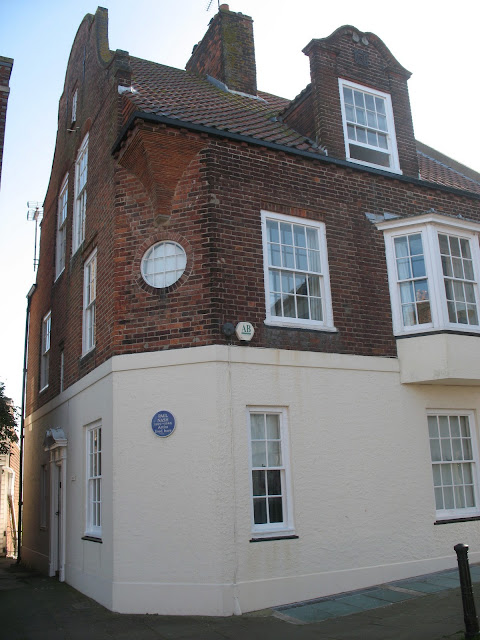 |
| Paul Nash, Landscape at Iden 1929 (Tate) |
Since I was eight or nine I've pictured the Battle of Hastings on a beach, like the Normandy landings of World War Two in reverse, so it was rather unsettling to drive through leafy hill country to the landlocked town of Battle. I was endeavouring to get from Eastbourne to Rye by as straightforward a route as possible, which turned out to be not very straightforward at all.
 |
| Paul Nash, Winchelsea Beach |
The plan was to find a campsite near Rye, but at 6 o'clock on a Sunday evening, as I trundled around the backroads north of the town, this was beginning to look rather unlikely. Eventually I stopped south of Appledore at the Ferry Inn, an old pub with a landlord from Chaucer, and they kindly helped me find a site near Winchelsea Beach.
Driving around in the evening sunlight I found myself in Iden, a village I knew from association with Paul Nash and his haunting 'Landscape at Iden'. Perhaps it is because of the painting that the name of the village is so evocative; the name, which for some reason I associate in my mind with the poet Robert Frost, suggests beauty and antiquity and peace on the one hand and, on the other, death. Well, I suppose that is Nash's fault.
 |
| Orchard at Iden |
The place itself is charming in a straggly sort of way and must have once - without the speeding lorries and vans - been an ideal artist's retreat. Bordered to the west by a huge orchard and to the north by the valley of the Rother, the village feels a bit like an island. The Nashes lived in the mid- to late-1920s in Oxenbridge - a sort of extension to the Iden - in a cottage Nash described as little more than a summer house, and the surrounding country is haunted by his work.
 |
| Paul Nash, Landscape, Stone Cliff |
It is a varied landscape, with thickly wooded hills, wide valleys and, only a mile or two away, the great expanse of Romney Marsh, which is bounded here and there by steeply sloping hills, and it evidently inspired Nash more than Rye itself. He and Margaret moved to the ancient hilltop town in 1930, after her mother died and her father needed to live with them, and there's a blue plaque on their house at the top of East Street - a rather eccentric house reminiscent of Nash's grave in Langley.
Rye at the time had a small but boisterous colony of artists and writers, notably the authors EF Benson and Radclyffe Hall. Nash became friends with the latter and with her partner Una, Lady Troubridge, whose appalling taste in art he forgave for some reason, and with Edward Burra and the American poet Conrad Aiken.
 |
| Rye: an unlikely outpost of Modernism |
Aiken once described Nash's 'love of beauty that was oddly both animal and mineral, and could be as soft as a cobweb... or the flesh of a woman, or as hard as one of the flints in his "Nest of Wild Stones"'.
 |
| Chez Nash 1930-33 |
The early 1930s were a tricky time for Nash, however, with a less-than-successful foray into abstraction and considerable soul-searching about his work. Visiting Rye, with its narrow streets isolated from the natural world (Burra, who lived there most of his life, called it Tinkerbell Town) one can understand how his mind became tight and tangled there.
He had got on much better along the coast at Dymchurch where, in the early 1920s, he painted at least two dozen pictures, both in oil and in watercolour.
 |
| Paul Nash, The Shore 1923 (Leeds Art Gallery) |
What I hadn't realised until I clambered up onto the sea wall to have a look is that he could have painted them all without moving more than a hundred yards or so. Rarely have I visited a place and found it so haunted by a painter.
He himself alluded to a certain therapeutic quality in his Dymchurch work, and one can see how the sheer bulk and wonderful geometry of the sea wall might have helped him to overcome the nervous strain of war.
 |
| Paul Nash, The Shore, Dymchurch |
An odd little place, Dymchurch must have been, with its handful of grand villas, its humble, pantile-roofed cottages, the marshes stretching away to the north and, looming over everything, the great mass of the wall. Subsequent history has layered amusement arcades and gift shops over the old buildings, but the wall, though recently improved, is still a thing of elegance and grace - modern, functional and as good a symbol of security as you could wish for in unstable times.
Look out for 'Paul Nash in Pictures: Landscape and Dream' - published this month by The Mainstone Press.
To be continued.


5 comments:
What a delicious blog full of tasty text and visual treats Mr Russell! I've had a smashing time reading through your previous posts. Thanks for stopping by at Serge & tweed. I look forward to reading more!
Best wishes
Do you know, please, where your last picture ("The Shore, Dymchurch)is conserved ?
Many thanks,
Erika.
Annarella, I think it is at the Whitworth Gallery at Manchester University, but you might want to check Andrew Causey's book on Nash which will confirm where it is.
I live in Iden and enjoyed looking at your site. No-one in the village has mentioned his connection so it was a surprise. I love Ravillious and am keen to visit the exhibition in Hastings. Thanks
Thanks - just to warn you there's only one Ravilious painting in the Hastings show: it's a group exhibition of 100 modern British artists.
Post a Comment